Physics Fundamentals: Motion, Energy Conservation, Waves & Magnetism
VerifiedAdded on 2023/06/15
|24
|2746
|209
Homework Assignment
AI Summary
This assignment provides detailed answers to physics questions covering fundamental concepts. It begins with defining velocity and acceleration, followed by explanations of Newton's laws of motion, including inertia and the relationship between force and momentum. The principle of conservation of energy is illustrated with examples like a swinging pendulum, and the conservation of momentum is explained using scenarios such as firing a bullet from a gun and rocket launches. The assignment then delves into wave properties, defining wavelength, frequency, and amplitude, differentiating between longitudinal and transverse waves, and discussing wave phenomena like reflection, refraction, and diffraction. It further explains the laws of reflection and refraction, including Snell's law, and the conditions necessary for total internal reflection, highlighting its application in optical fibers. Finally, the assignment covers magnetism, defining magnetic fields and illustrating magnetic field lines around a bar magnet and current-carrying wires, as well as explaining electric current and potential difference. This comprehensive overview provides a solid foundation in key physics principles, and Desklib offers more solved assignments and study resources for students.
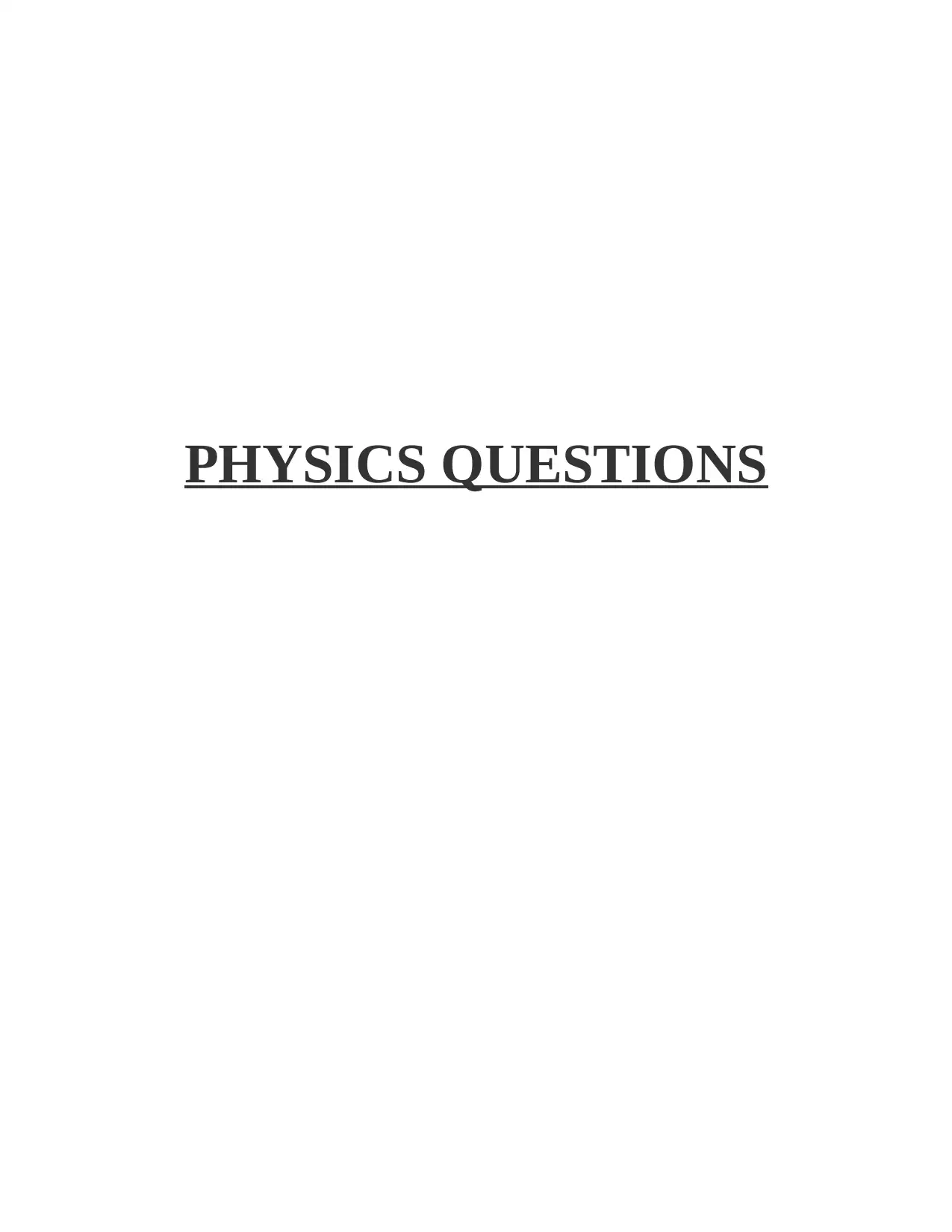
PHYSICS QUESTIONS
Paraphrase This Document
Need a fresh take? Get an instant paraphrase of this document with our AI Paraphraser


TABLE OF CONTENTS
MAIN BODY..................................................................................................................................4
QUESTIONS...................................................................................................................................4
REFERENCES..............................................................................................................................22
MAIN BODY..................................................................................................................................4
QUESTIONS...................................................................................................................................4
REFERENCES..............................................................................................................................22
⊘ This is a preview!⊘
Do you want full access?
Subscribe today to unlock all pages.

Trusted by 1+ million students worldwide

MAIN BODY
QUESTIONS
1.1
Velocity define as the rate of change in the position which is respect to the reference frame and
time. velocity is identical to the provision of speed of objects and its motion direction.
Acceleration define as the rate in which the change of the velocity is done with respect to time
(Antonov, 2021).
VELOCITY ACCELERATION
Its nature is vector. It is also operate in vector nature.
Usually calculated with displacement Calculated with the velocity
Its formula and unit is displacement/time
And unit is meter per second (m/s).
Formula is velocity per time and unit is meter
per second square (m/s2)
Positive Generally negative
It generally ascertain that how rapidly the
object is moving and in what direction.
It ascertain as how quickly the velocity of the
object is changes within time.
QUESTIONS
1.1
Velocity define as the rate of change in the position which is respect to the reference frame and
time. velocity is identical to the provision of speed of objects and its motion direction.
Acceleration define as the rate in which the change of the velocity is done with respect to time
(Antonov, 2021).
VELOCITY ACCELERATION
Its nature is vector. It is also operate in vector nature.
Usually calculated with displacement Calculated with the velocity
Its formula and unit is displacement/time
And unit is meter per second (m/s).
Formula is velocity per time and unit is meter
per second square (m/s2)
Positive Generally negative
It generally ascertain that how rapidly the
object is moving and in what direction.
It ascertain as how quickly the velocity of the
object is changes within time.
Paraphrase This Document
Need a fresh take? Get an instant paraphrase of this document with our AI Paraphraser
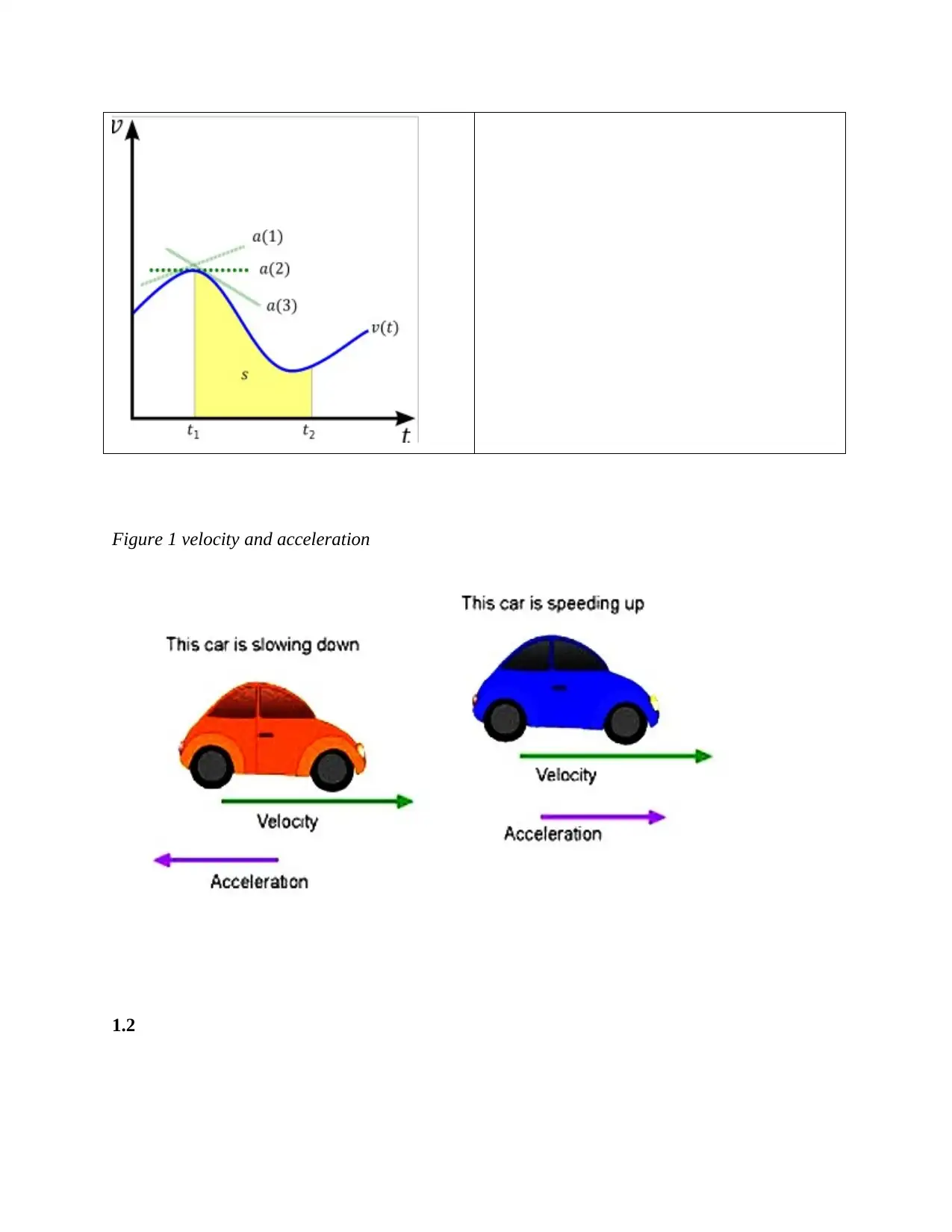
Figure 1 velocity and acceleration
1.2
1.2
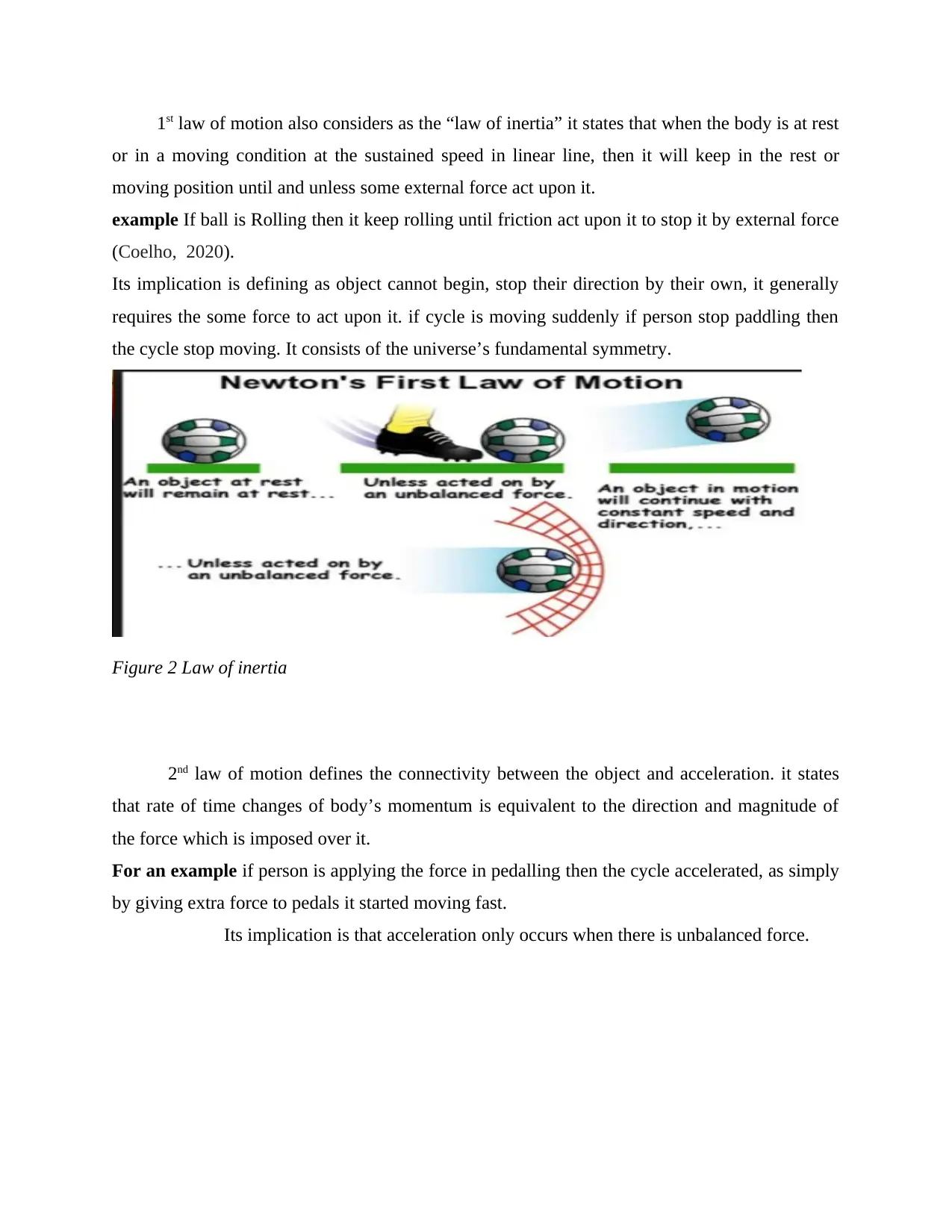
1st law of motion also considers as the “law of inertia” it states that when the body is at rest
or in a moving condition at the sustained speed in linear line, then it will keep in the rest or
moving position until and unless some external force act upon it.
example If ball is Rolling then it keep rolling until friction act upon it to stop it by external force
(Coelho, 2020).
Its implication is defining as object cannot begin, stop their direction by their own, it generally
requires the some force to act upon it. if cycle is moving suddenly if person stop paddling then
the cycle stop moving. It consists of the universe’s fundamental symmetry.
Figure 2 Law of inertia
2nd law of motion defines the connectivity between the object and acceleration. it states
that rate of time changes of body’s momentum is equivalent to the direction and magnitude of
the force which is imposed over it.
For an example if person is applying the force in pedalling then the cycle accelerated, as simply
by giving extra force to pedals it started moving fast.
Its implication is that acceleration only occurs when there is unbalanced force.
or in a moving condition at the sustained speed in linear line, then it will keep in the rest or
moving position until and unless some external force act upon it.
example If ball is Rolling then it keep rolling until friction act upon it to stop it by external force
(Coelho, 2020).
Its implication is defining as object cannot begin, stop their direction by their own, it generally
requires the some force to act upon it. if cycle is moving suddenly if person stop paddling then
the cycle stop moving. It consists of the universe’s fundamental symmetry.
Figure 2 Law of inertia
2nd law of motion defines the connectivity between the object and acceleration. it states
that rate of time changes of body’s momentum is equivalent to the direction and magnitude of
the force which is imposed over it.
For an example if person is applying the force in pedalling then the cycle accelerated, as simply
by giving extra force to pedals it started moving fast.
Its implication is that acceleration only occurs when there is unbalanced force.
⊘ This is a preview!⊘
Do you want full access?
Subscribe today to unlock all pages.

Trusted by 1+ million students worldwide
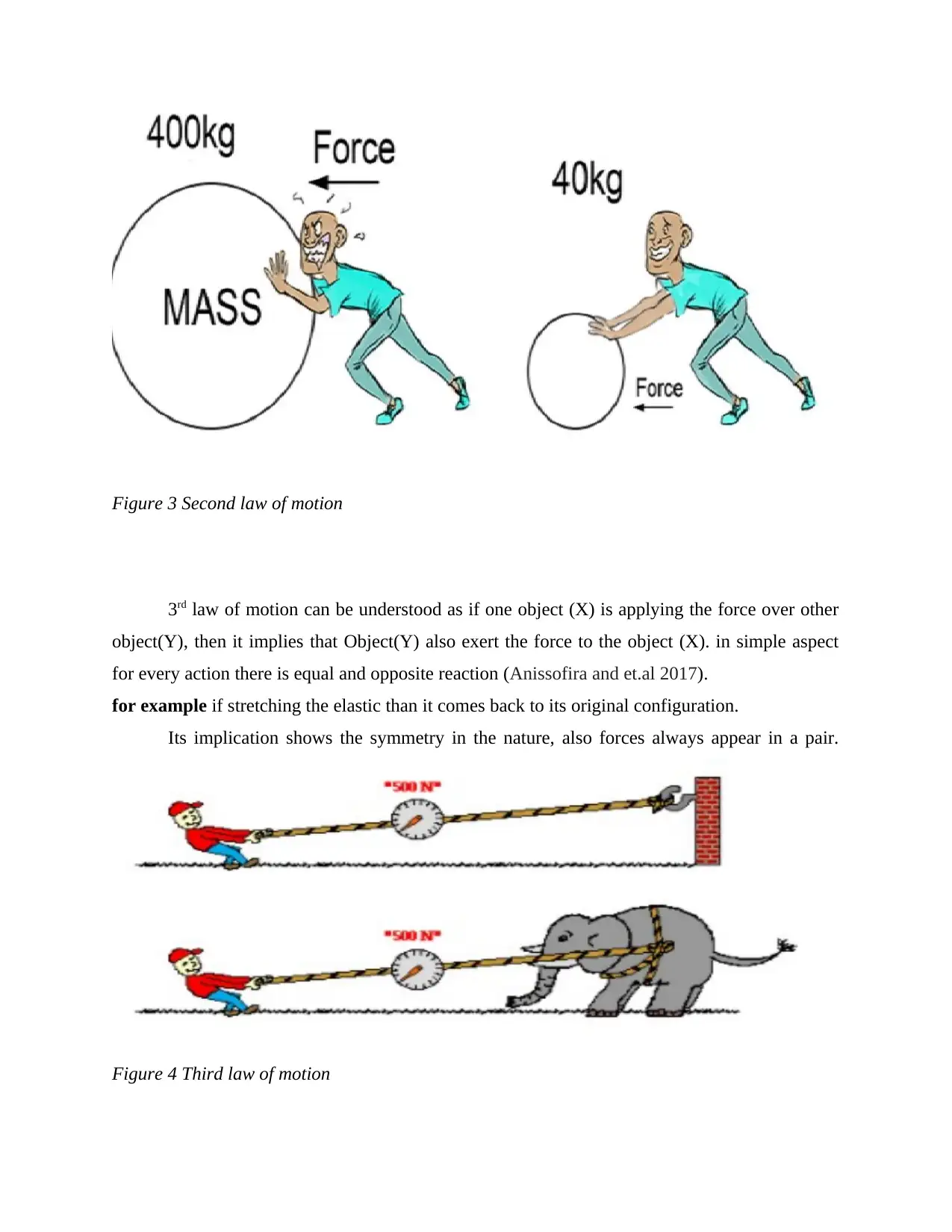
Figure 3 Second law of motion
3rd law of motion can be understood as if one object (X) is applying the force over other
object(Y), then it implies that Object(Y) also exert the force to the object (X). in simple aspect
for every action there is equal and opposite reaction (Anissofira and et.al 2017).
for example if stretching the elastic than it comes back to its original configuration.
Its implication shows the symmetry in the nature, also forces always appear in a pair.
Figure 4 Third law of motion
3rd law of motion can be understood as if one object (X) is applying the force over other
object(Y), then it implies that Object(Y) also exert the force to the object (X). in simple aspect
for every action there is equal and opposite reaction (Anissofira and et.al 2017).
for example if stretching the elastic than it comes back to its original configuration.
Its implication shows the symmetry in the nature, also forces always appear in a pair.
Figure 4 Third law of motion
Paraphrase This Document
Need a fresh take? Get an instant paraphrase of this document with our AI Paraphraser

2.2
The principle of conservation of energy states that the energy of an isolated system remains
conserved. It means that energy can neither be created, nor be destroyed, it can only be
transformed from one form to another. For example, when a pendulum is made to swung in
upward direction, the kinetic energy possessed by the pendulum, by the virtue of its motion, gets
converted into potential energy. Such that the total energy of the system is constant and equal to
the sum of kinetic energy and potential energy. When the pendulum is at its extreme end, it stops
for a while. The kinetic energy at this point is zero and the total energy of the system is equal to
the potential energy. Therefore, the total energy of this system is remaining constant as the
pendulum swings (Raissi, Perdikaris and Karniadakis, 2017). The energy is only getting
transformed into different forms, i.e, potential energy and kinetic energy.
Illust
ration 1: Principle of Conservation of Energy
The principle of conservation of energy states that the energy of an isolated system remains
conserved. It means that energy can neither be created, nor be destroyed, it can only be
transformed from one form to another. For example, when a pendulum is made to swung in
upward direction, the kinetic energy possessed by the pendulum, by the virtue of its motion, gets
converted into potential energy. Such that the total energy of the system is constant and equal to
the sum of kinetic energy and potential energy. When the pendulum is at its extreme end, it stops
for a while. The kinetic energy at this point is zero and the total energy of the system is equal to
the potential energy. Therefore, the total energy of this system is remaining constant as the
pendulum swings (Raissi, Perdikaris and Karniadakis, 2017). The energy is only getting
transformed into different forms, i.e, potential energy and kinetic energy.
Illust
ration 1: Principle of Conservation of Energy

2.3
For a moving object, its momentum is equal to the product of its mass and its velocity.
Momentum is a vector quantity, that means it possess both magnitude and direction. The total
momentum of isolated systems remains constant. For a system, consisting of several objects, the
total momentum is the sum of momenta of all the individual objects.
For instance, when a bullet is fired from a gun, the gun recoils in the opposite direction. This is
because of the law of conservation of momentum. Initially, both gun and the bullet inside the
gun, is at rest and the total momentum of the system is zero (Handhika, Cari and Suparmi,
2017). When the bullet is fired from the gun, it gains momentum. But the net momentum must
remain zero. So the gun gains an equal and opposite momentum to cancel out the momentum of
the bullet and it recoils backward.
Similarly, during a rocket launch, due to the downward thrust of the gases, the rocket gains a
momentum in the upward direction and that is how it is able to fly in the up.
Another example could be that of an inflated balloon. Initially it is at rest, but as soon as air
escapes out of it, the balloon gains momentum and flies forward.
Illustration 2: Conservation of momentum
For a moving object, its momentum is equal to the product of its mass and its velocity.
Momentum is a vector quantity, that means it possess both magnitude and direction. The total
momentum of isolated systems remains constant. For a system, consisting of several objects, the
total momentum is the sum of momenta of all the individual objects.
For instance, when a bullet is fired from a gun, the gun recoils in the opposite direction. This is
because of the law of conservation of momentum. Initially, both gun and the bullet inside the
gun, is at rest and the total momentum of the system is zero (Handhika, Cari and Suparmi,
2017). When the bullet is fired from the gun, it gains momentum. But the net momentum must
remain zero. So the gun gains an equal and opposite momentum to cancel out the momentum of
the bullet and it recoils backward.
Similarly, during a rocket launch, due to the downward thrust of the gases, the rocket gains a
momentum in the upward direction and that is how it is able to fly in the up.
Another example could be that of an inflated balloon. Initially it is at rest, but as soon as air
escapes out of it, the balloon gains momentum and flies forward.
Illustration 2: Conservation of momentum
⊘ This is a preview!⊘
Do you want full access?
Subscribe today to unlock all pages.

Trusted by 1+ million students worldwide

3.1
There are mainly three terms that are used to describe a wave: wavelength, frequency and
amplitude.
The amplitude of a wave is the height of the wave and it is equal to half of the distance between
the highest point (crest) and the lowest point (trough). The SI unit of amplitude is metre (m).
Wavelength is the distance between two crests or two trough. The SI unit of wavelength is metre
(m). Wavelength and frequency are indirectly proportional. Frequency is measured as the
number of waves that pass through a point in a given time period (Bejan and Errera, 2017).
Frequency is expressed in hertz (Hz).
Other terms associated with a wave are: Time period, Peak and Trough. Time period is the time
taken by the wave to complete one cycle. It is measure in seconds (s). It is inversely proportional
to Frequency. Peak is the highest point of the wave, while Trough is the lowest point of the
wave.
There are mainly three terms that are used to describe a wave: wavelength, frequency and
amplitude.
The amplitude of a wave is the height of the wave and it is equal to half of the distance between
the highest point (crest) and the lowest point (trough). The SI unit of amplitude is metre (m).
Wavelength is the distance between two crests or two trough. The SI unit of wavelength is metre
(m). Wavelength and frequency are indirectly proportional. Frequency is measured as the
number of waves that pass through a point in a given time period (Bejan and Errera, 2017).
Frequency is expressed in hertz (Hz).
Other terms associated with a wave are: Time period, Peak and Trough. Time period is the time
taken by the wave to complete one cycle. It is measure in seconds (s). It is inversely proportional
to Frequency. Peak is the highest point of the wave, while Trough is the lowest point of the
wave.
Paraphrase This Document
Need a fresh take? Get an instant paraphrase of this document with our AI Paraphraser
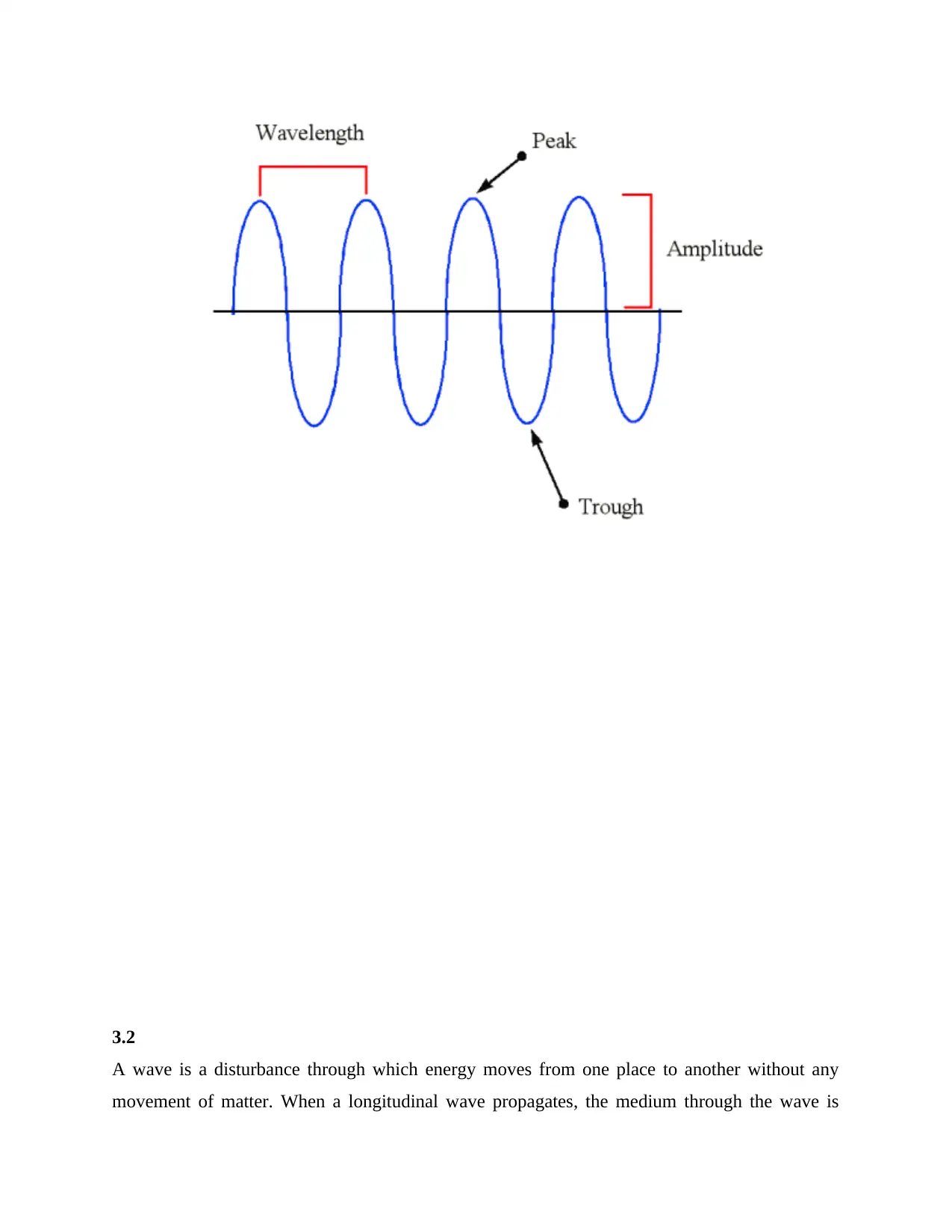
3.2
A wave is a disturbance through which energy moves from one place to another without any
movement of matter. When a longitudinal wave propagates, the medium through the wave is
A wave is a disturbance through which energy moves from one place to another without any
movement of matter. When a longitudinal wave propagates, the medium through the wave is
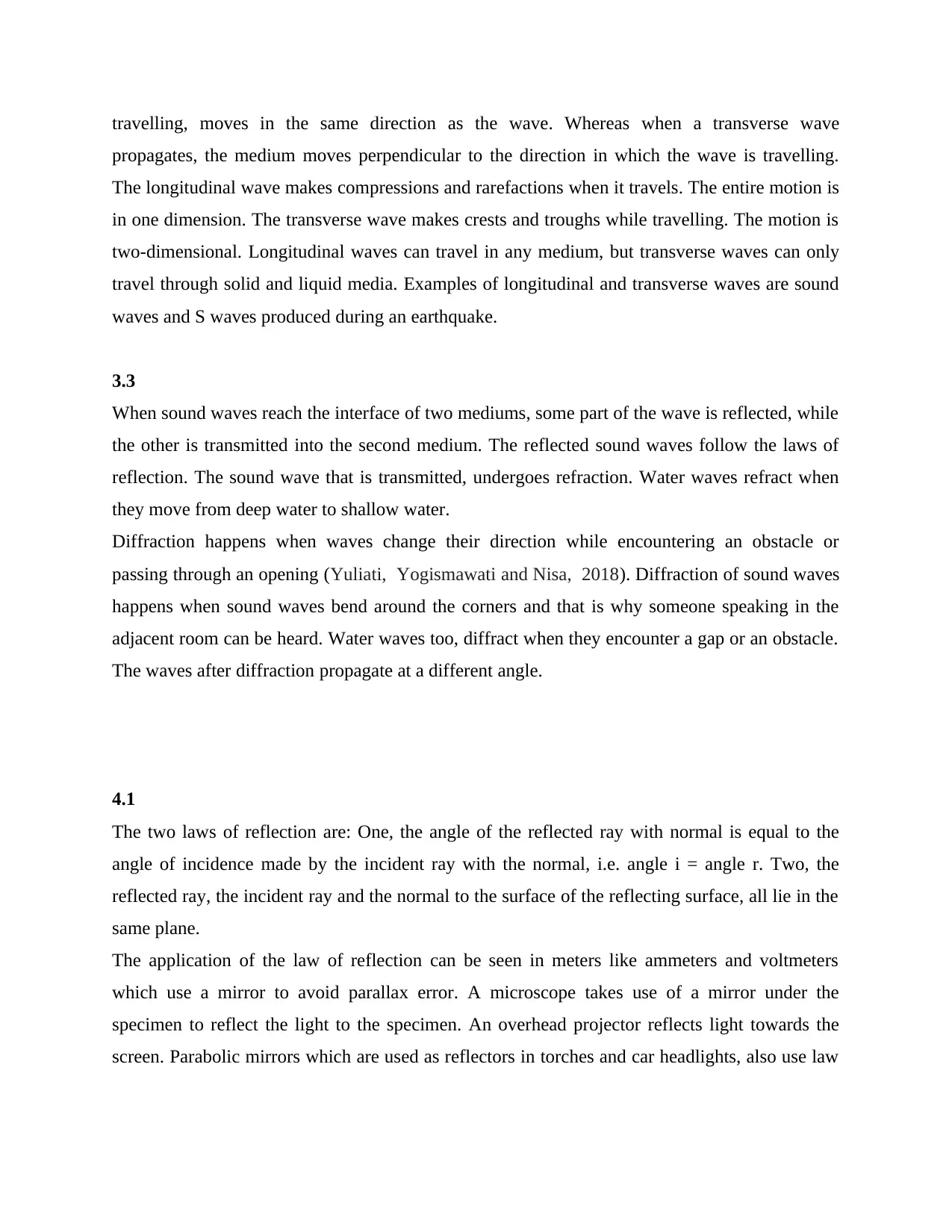
travelling, moves in the same direction as the wave. Whereas when a transverse wave
propagates, the medium moves perpendicular to the direction in which the wave is travelling.
The longitudinal wave makes compressions and rarefactions when it travels. The entire motion is
in one dimension. The transverse wave makes crests and troughs while travelling. The motion is
two-dimensional. Longitudinal waves can travel in any medium, but transverse waves can only
travel through solid and liquid media. Examples of longitudinal and transverse waves are sound
waves and S waves produced during an earthquake.
3.3
When sound waves reach the interface of two mediums, some part of the wave is reflected, while
the other is transmitted into the second medium. The reflected sound waves follow the laws of
reflection. The sound wave that is transmitted, undergoes refraction. Water waves refract when
they move from deep water to shallow water.
Diffraction happens when waves change their direction while encountering an obstacle or
passing through an opening (Yuliati, Yogismawati and Nisa, 2018). Diffraction of sound waves
happens when sound waves bend around the corners and that is why someone speaking in the
adjacent room can be heard. Water waves too, diffract when they encounter a gap or an obstacle.
The waves after diffraction propagate at a different angle.
4.1
The two laws of reflection are: One, the angle of the reflected ray with normal is equal to the
angle of incidence made by the incident ray with the normal, i.e. angle i = angle r. Two, the
reflected ray, the incident ray and the normal to the surface of the reflecting surface, all lie in the
same plane.
The application of the law of reflection can be seen in meters like ammeters and voltmeters
which use a mirror to avoid parallax error. A microscope takes use of a mirror under the
specimen to reflect the light to the specimen. An overhead projector reflects light towards the
screen. Parabolic mirrors which are used as reflectors in torches and car headlights, also use law
propagates, the medium moves perpendicular to the direction in which the wave is travelling.
The longitudinal wave makes compressions and rarefactions when it travels. The entire motion is
in one dimension. The transverse wave makes crests and troughs while travelling. The motion is
two-dimensional. Longitudinal waves can travel in any medium, but transverse waves can only
travel through solid and liquid media. Examples of longitudinal and transverse waves are sound
waves and S waves produced during an earthquake.
3.3
When sound waves reach the interface of two mediums, some part of the wave is reflected, while
the other is transmitted into the second medium. The reflected sound waves follow the laws of
reflection. The sound wave that is transmitted, undergoes refraction. Water waves refract when
they move from deep water to shallow water.
Diffraction happens when waves change their direction while encountering an obstacle or
passing through an opening (Yuliati, Yogismawati and Nisa, 2018). Diffraction of sound waves
happens when sound waves bend around the corners and that is why someone speaking in the
adjacent room can be heard. Water waves too, diffract when they encounter a gap or an obstacle.
The waves after diffraction propagate at a different angle.
4.1
The two laws of reflection are: One, the angle of the reflected ray with normal is equal to the
angle of incidence made by the incident ray with the normal, i.e. angle i = angle r. Two, the
reflected ray, the incident ray and the normal to the surface of the reflecting surface, all lie in the
same plane.
The application of the law of reflection can be seen in meters like ammeters and voltmeters
which use a mirror to avoid parallax error. A microscope takes use of a mirror under the
specimen to reflect the light to the specimen. An overhead projector reflects light towards the
screen. Parabolic mirrors which are used as reflectors in torches and car headlights, also use law
⊘ This is a preview!⊘
Do you want full access?
Subscribe today to unlock all pages.

Trusted by 1+ million students worldwide
1 out of 24
Related Documents
Your All-in-One AI-Powered Toolkit for Academic Success.
+13062052269
info@desklib.com
Available 24*7 on WhatsApp / Email
![[object Object]](/_next/static/media/star-bottom.7253800d.svg)
Unlock your academic potential
Copyright © 2020–2026 A2Z Services. All Rights Reserved. Developed and managed by ZUCOL.





